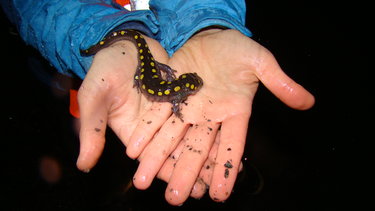Volunteers sought to help frogs and salamanders safely cross roads to breed
In mid-March, amphibians typically migrate to breed. Volunteers are sought to help them safely cross roads as they travel from forests to vernal ponds.
Now in its 14th year, the state Department of Environmental Conservation’s Amphibian Migrations and Road Crossings Project was initiated by the Hudson River Estuary Program and Cornell University to raise awareness about critical amphibian habitat, engage volunteers to help collect data on the annual migration, and reduce amphibian road mortality.
More than 800 volunteers have participated in the effort since 2009, and helped move about 30,000 salamanders, frogs, and toads safely across roads.
In the coming weeks, as temperatures rise and snow melts, forest species like wood frog (Lithobates sylvatica), spotted salamander (Ambystoma maculatum), and Jefferson-blue spotted salamander complex (Ambystoma jeffersonianum x laterale) will emerge from underground winter shelters and head to vernal pools for breeding.
Vernal pools are small, temporary wetlands in the forest that are critical breeding habitat for these amphibians. The pools hold water until summer, so the adult amphibians must gather, breed, and deposit eggs early enough to ensure their aquatic young can hatch, grow, and leave the pools before the pools dry up.
The timing of migration depends on the weather and, in the Hudson Valley, activity is concentrated on the first warm, rainy nights in March, after the ground has thawed and night air temperatures remain above 40 degrees Fahrenheit.
The suitability of migration conditions varies throughout the Hudson River estuary watershed, but when it’s just right, there can be explosive “big night” migrations with hundreds of amphibians on the move. On their journeys between forest habitat and breeding pools, these amphibians often need to cross roads, where mortality can be high even when traffic is low.
Project volunteers document road locations where they observe migrations, record weather and traffic conditions, and identify and count the amphibians on the move. Volunteers also carefully help the amphibians to safely cross roads.
Since the project started, volunteers have documented 20 species and counted 32,500 live amphibians, as well as nearly 14,000 migrating amphibians killed by passing vehicles. Species reported most frequently during migration nights include spotted salamander, wood frog, and spring peeper (Pseudacris crucifer).
To a lesser degree, volunteers have also observed Jefferson-blue spotted salamander complex and four-toed salamander (Hemidactylium scutatum), species of conservation concern in New York.
Safety is critical, and project volunteers are expected to take all necessary precautions. Volunteers are advised to wear reflective safety vests and headlamps to increase visibility on dark roads, and should not interfere with passing vehicles.
Amphibian safety is also important, and frogs and salamanders should only be handled with care and clean hands, free of hand sanitizer, lotion, and other substances that can be toxic to amphibians’ porous skin.
For more information, including a short video about amphibian migrations, visit the DEC’s website. The DEC held a virtual training for volunteers in February with 105 participants.
New Yorkers interested in volunteering to participate in this annual event are encouraged to watch a series of training videos on YouTube and read the Volunteer Handbook. In addition, potential volunteers can access a recording of the training and use materials available on the project website to learn more, including where groups in the Hudson Valley are helping to organize local volunteers.
Anyone interested in receiving project updates and news about the migration can subscribe to the project e-newsletter through DEC Delivers.
